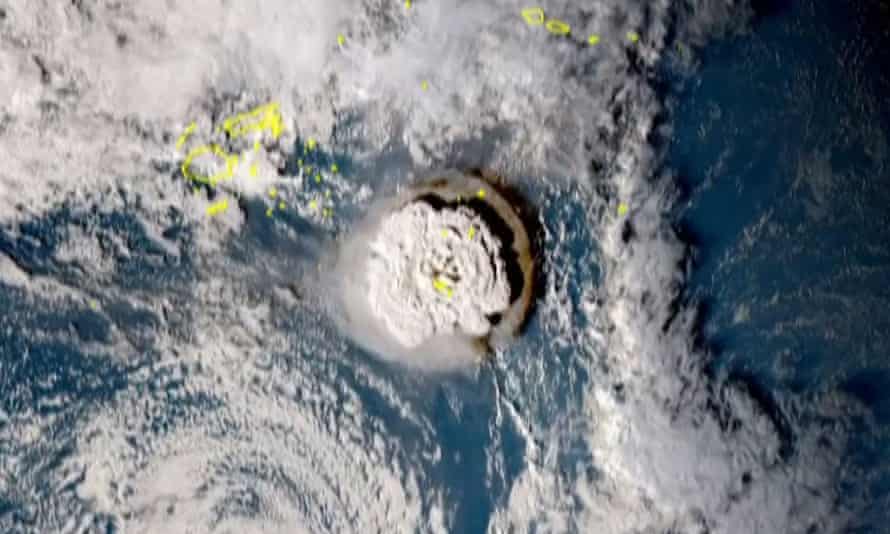Streets and buildings flooded in Pacific nation’s main island following latest eruption of Hunga Tonga-Hunga Ha’apai
People have been forced to flee their homes and streets and buildings have flooded as tsunami waves crashed into Tonga’s main island of Tongatapu, following a huge underwater volcano explosion.
A tsunami advisory was in effect for Hawaii, Alaska, the US Pacific coast and Japan, with reports of waves throwing boats up into the docks in Hawaii.
The Japan Meteorological Agency said tsunami reached that country’s Pacific coast, too, with waves as high as three metres (11 feet) possible.
A 1.2-metre wave reached the remote southern island of Amami Oshima and other areas along Japan’s Pacific coast observed smaller surges, the agency said.
In Hawaii, the Pacific Tsunami Warning Center reported waves slamming ashore from half a metre (1.6 feet) in Nawiliwili, Kauai, to 80 centimetres (2.7 feet) in Hanalei. “We are relieved that there is no reported damage and only minor flooding throughout the islands,” the centre said.
On Tonga, home to about 105,000 people, video posted on social media showed large waves washing ashore in coastal areas, swirling around homes and buildings, including a church.

The eruption at 0410 GMT of the Hunga Tonga-Hunga Ha’apai underwater volcano, located about 65km (40 miles) north of Tonga’s capital, Nuku’alofa, caused a 1.2-metre tsunami, Australia’s Bureau of Meteorology said.
The eruption – captured in satellite images that show a huge plume of ash, steam and gas rising from the ocean – was heard and felt as far away as in Fiji and Vanuatu, where people reported feeling the ground and buildings shaking for hours.
There were no immediate reports of injuries or the extent of the damage in Tonga, but online videos showed huge waves in coastal areas, swirling around homes and buildings.
Communications and power were reportedly out across Tonga’s main island, and the government called up military reserves to assist with the response to the disaster.
Islands Business reported that a convoy of police and military troops evacuated King Tupou VI from his palace near the shore, and local news site Kaniva Tonga reported long lines of traffic as thousands of people attempted to reach higher ground across the main island.
Dr Faka’iloatonga Taumoefolau, a project coordinator working with the Tongan parliament, said the explosion had led to a fall of “ash and tiny pebbles, darkness blanketing the sky”.
Tsunami waves of 2.7 ft (82 cm) were observed by gauges in the Tongan capital, and waves of 2 ft in Pago Pago, the capital of American Samoa, the Pacific Tsunami Warning Center said.
The Fijian government issued a tsunami warning, telling people in coastal parts of the country to move to higher ground due to “larger than usual waves”. There were reports that some Fijian villages had been inundated and families evacuated.
In Japan, Hawaii, Alaska and along the US Pacific coast, residents were asked to move away from the coastline to higher ground and pay attention to specific instructions from their local emergency management officials, said Dave Snider, tsunami warning coordinator for the National Tsunami Warning Center in Palmer, Alaska.
Beaches and piers were closed across southern California as a precaution, but the National Weather Service tweeted that there were “no significant concerns about inundation”.
Strong rip currents were possible, however, and officials warned people to stay out of the water.
Residents of American Samoa were alerted to the tsunami by local broadcasters as well as church bells ringing across the territory. An outdoor siren warning system was out of service. Those living along the shoreline quickly moved to higher ground.
Jese Tuisinu, a television reporter at Fiji One, posted a video on Twitter showing large waves washing ashore and people trying to flee from the oncoming waves in their cars. “It is literally dark in parts of Tonga and people are rushing to safety following the eruption,” he said.
New Zealand’s emergency management agency issued an advisory on tsunami activity for its northern and eastern coasts, saying the areas were expected to experience strong and unusual currents and unpredictable surges at the shore.
On Friday, the volcano sent ash, steam and gas up to 20km into the air, with a radius of 260km, Tonga Geological Services said in a Facebook post.
